Protecting Your Digital Banking Details Is Crucial

Nearly a decade ago, people would physically gain access to financial services by visiting a bank. Transactions were a stark procedure, and long queues till the end of banking hours bothered everyone. Today, however, the situation has shifted 180 degrees, and in a good way. Smartphones, digital banking apps, quick online access to financial instruments, and customer engagement platforms have changed the way we think about money. What comes next?
As we all know, online banking has many benefits. However, it is possible for threats to arise from hackers and fraudsters without you realizing it.
Hackers try to get cozy between parties that exchange information. When breached, they steal your info and abuse it in order to break into your account. This puts your money at high risk, and things could take a pretty hard left turn from here on out.
So, what are the best practices that help ensure the safety of your digital banking experience? The following info provides succinct steps to ensure a safe online presence in the banking sector. Get in!
Basic Foundation
This one’s a little too obvious, we understand. Your choice of password can create an opening for hackers, even if you don’t realize it.
Some of the most common mistakes people make with online banking passwords include:
Using personal information (name, address, date of birth)
Choosing short passwords
Relying on common words or weak number combinations
Using the same password for multiple logins (something 83% of online banking customers do)
Not updating passwords regularly
Following the aforementioned steps definitely makes remembering passwords easier, but the risk factor still remains. Here are a few tips for setting stronger passwords for banking applications:
Choose longer passwords, such as a phrase rather than a single word
Use a mix of upper and lowercase letters
Include numbers and special characters
Avoid common sequences, such as “1234”
Avoid using personal information, such as your name, pets’ names, date of birth, etc.
Don’t store your login details in your online banking or mobile app
Update your banking passwords regularly. It makes life more difficult for scam artists or hackers who want nothing more than making life difficult for you.
Two-Step Verification To Protect Digital Banking
Your security game is taken to a whole other level if your bank offers a multi-factor verification sequence
A multi-layered authentication process allows you to add extra layers of security before safely logging into your account. For instance, when frequenting your preferred online banking platform, you initially enter a login name and password. Then, a second security test appears that helps verify if it’s really you trying to sign in.
For example, HBL Konnect offers customers the option to get a special code – or OTP – on their phones when logging in. This makes it harder for hackers or identity thieves to unlock your account!
Check with your bank to see if multi-factor authentication is an option. If it is, you may just need to download a free authentication app to get your account set up.









